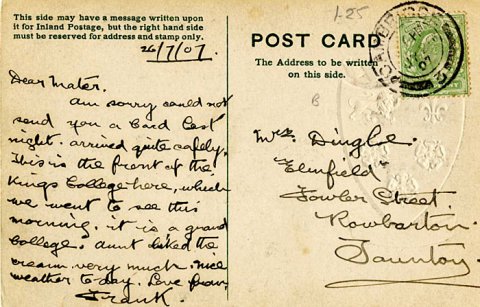
March 2011
Everything from rude cartoons to historic buildings have featured on postcards. King's has appeared on cards since the 1880s, and this month we look at postcards of King's from this period until 1940.
Early postcards
Picture postcards first appeared in France in 1870. But it wasn't until 1889 when cards of the newly-built Eiffel Tower appeared that the postcard became popular. The finest early postcards were produced in Germany and had the brightest colours and most accomplished artwork.
Until the late 1890s postcards were blank on the back and it was illegal to write anything other than the address on the reverse of the card. Until 1907 the sender wrote across the front over the photographs or artwork on the card. After the creation of divided backs people started to use the backs of cards as we do today - for the message and the address - leaving the front of the cards untouched.
Post WWI
Bombing of German and English publishing firms during the First World War severely damaged postcard production, with two exceptions: the hand-tinted card and the photographic view card. Hand-tinted cards produced in France and Belgium were photo postcards that were hand coloured to give them a 'natural' look. The process eventually died out as it was labour intensive and the lead paint the women used to paint the cards made them ill.
In the 1930s the invention of the rotary drum printer and the colour photochrome process meant that viewcard production boomed. Not only could publishers print thousands of cards of one image, but they could produce high quality colour photos.
By the outbreak of WWII kerb-side postcard racks had sprung up at every tourist attraction. Today these racks line Cambridge's streets and many of the cards still feature King's.
